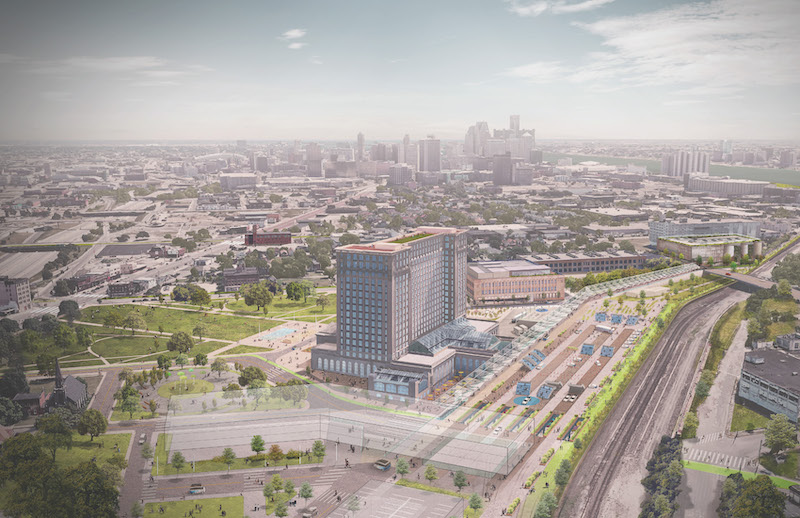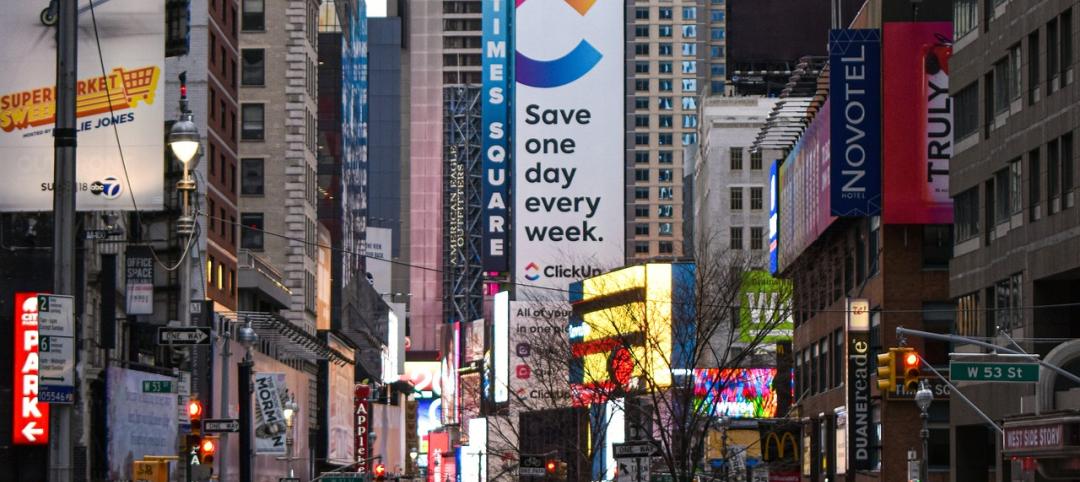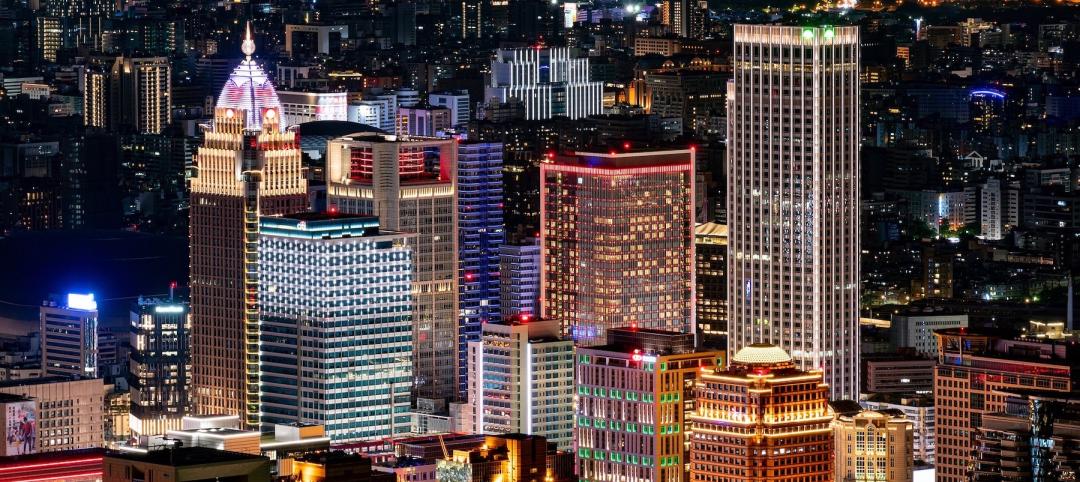Any conversation about what’s wrong with urban America is bound to bring up Detroit at some point. That metro’s July 2013 bankruptcy—the largest municipal filing in U.S. history—culminated decades of mismanagement and corruption that, coupled with rampant crime, caused residents and businesses to flee and tax revenue to plummet, creating a vicious cycle that the once-mighty Motor City, while improving lately, still struggles to reverse.
In Corktown, Detroit’s oldest neighborhood, sits Michigan Central Station, a Beaux-Arts Classical style passenger train depot that opened in 1914. The building, with its grand waiting room and tiled ceiling that soars 230 ft above, represented the city’s glory years. But after it closed in 1988, the station devolved into a pitiable ruin that both manifested and symbolized Detroit’s deterioration. The building’s decay served as the opening images in the third installation of Godfrey Reggio’s The Qatsi Trilogy, a bleak film documentary series that explores how technological and industrial forces had conspired to put human life out of balance.
So it was, perhaps, with a sense of irony that Ford Motor Co., the world’s fourth-largest carmaker, acquired Michigan Central Station in May 2018, and last month unveiled plans to place a reconstructed and repurposed station at the center of a new 30-acre mobility innovation district with 1.2 million sf of commercial space.
Ford has invested $740 million in this redevelopment project, which is part of its executive chairman Bill Ford’s “reimagining of the future of mobility,” says Carolina Pluszczynski, the district’s director of development. “Mobility,” for Ford, encompasses everything from autonomous vehicles to drones and robots, says Pluszczynski. The district will be an open platform that encourages collaboration with other partners. And there has been discussion within Michigan about the district becoming a “node” of a larger “mobility corridor” that would stretch from Detroit to Dearborn to Ann Arbor.
COMMUNITY INPUT GUIDES MOBILITY DISTRICT’S PLANNING
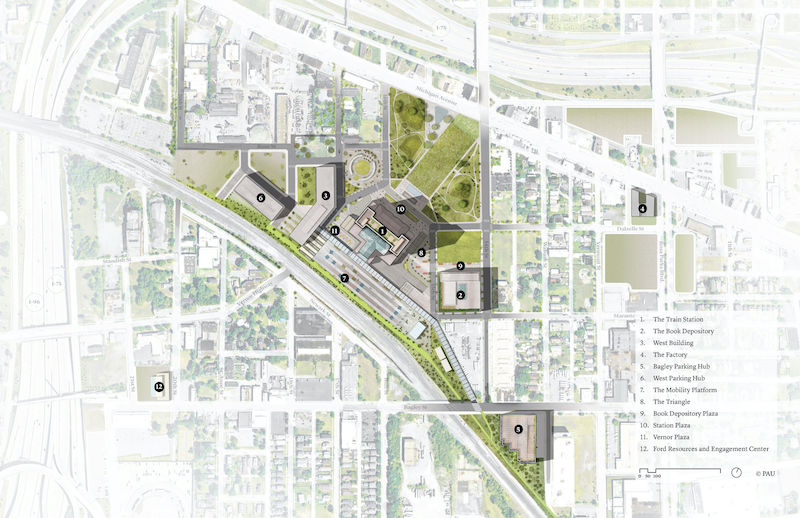
The 30-acre site, located in the Corktown neighborhood in western Detroit, will have four main buildings, including Building West, which is new construction. Parking hubs dot the site's periphery. Image: Practice for Architecture and Urbanism
Practice for Architecture and Urbanism (PAU) is the district project’s lead architect and strategic planner. Mark Faulkner, its Associate Principal, lauds Ford for its attempt at “bringing a piece of history back to life.” The core design themes focus on concentrating density around the station, and wending a walkable area through a unique grouping of buildings and shared spaces that creates a “neighborhood of the future, by everyone, for everyone.”
To develop the site plan, Ford and PAU conducted 18 months of research that was informed by more than 100 hours of discussions with stakeholders and the community.
Michigan Central Station is a massive structure: its 640,000 sf over 18 floors include a basement, the first floor (including the grand waiting room and concourse area) that is being converted for restaurants, retail, and public spaces; a mezzanine floor, two utility floors, 10 floors of a tower that will accommodate office space, and three floors of the tower earmarked for hospitality.
The reconstruction of Michigan Central Station—with Quinn Evans Architects and AvroKO serving as design-architects, and the minority-owned firms Christman and Brinker forming a construction management joint venture—is underway. To scan the building’s interior, Ford hired engineers from Computer Aided Technology Inc., which supplies the carmaker with 3D printing software and hardware.
Also see: A video walk-through of the early stages of Michigan Central Station’s reconstruction
In September, Ford and Christman|Brinker, in collaboration with Detroit at Work, Workforce Development Institute, Barton Malow, SkillSmart, and the Michigan Building and Construction Trades Council, launched “Fast Track,” a jobs program at Michigan Central Station, which provides a pathway from existing training and on-board programs to skilled city workers for future construction. The first 25-person cohort in this program joined 140 construction workers already on-site.
The Central Station’s reconstruction is scheduled for completion by the end of 2022, with the first tenants moving in the first half of 2023. Pluszczynski says that while Ford hasn’t signed any tenants yet, it has activated some programming with local startups. Ford has also partnered with Newlab, which pairs technology experts with industry and civic leaders to empower entrepreneurs. That alliance has already launched two studios—one that addresses macro mobility issues and another that addresses local civic mobility—that eventually will live within the district.
INNOVATION HUB WILL CONNECT THE DISTRICT’S SPACE
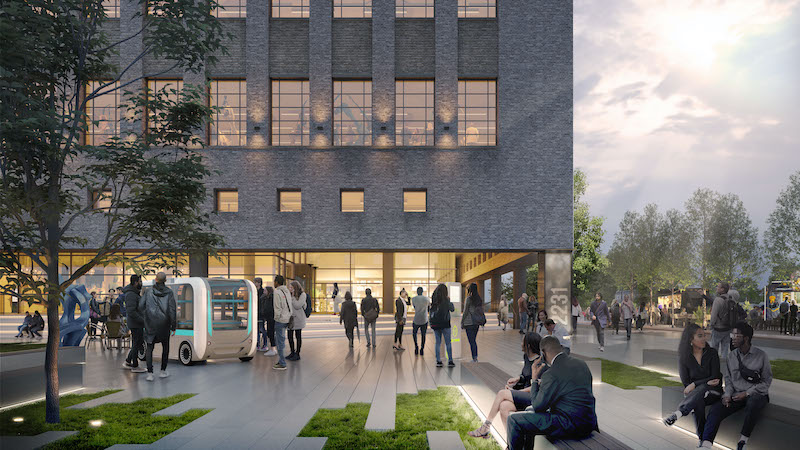
The three-floor Book Depository will become the district's innovation hub. It will reflect the latest thinking in workplace design, and its makeover will include a new roofdeck terrace. Images: Gensler
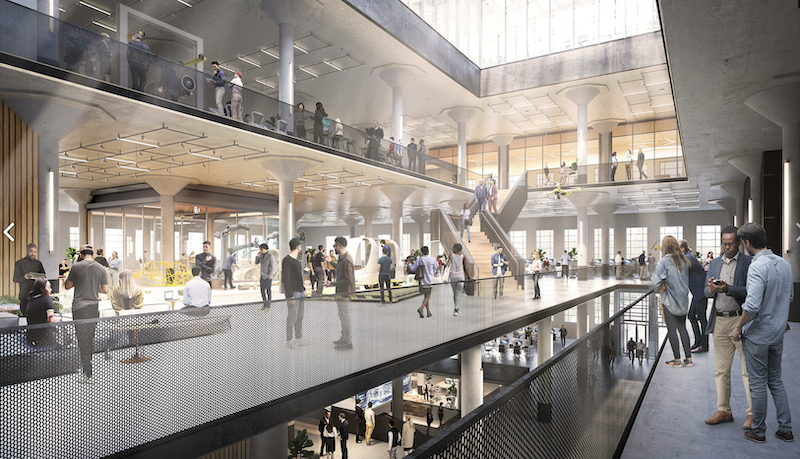
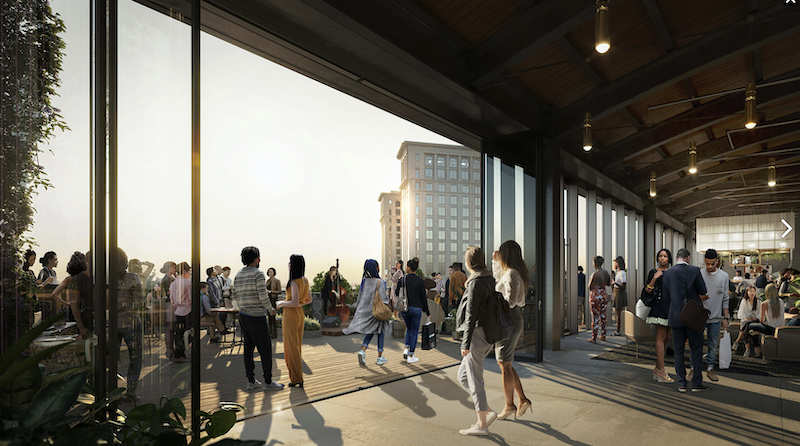
Ford also acquired the former Detroit Public Schools Book Depository, originally designed by Alfred Kahn in the 1930s.This 290,000-sf building will become the district’s primary innovation center for mobility solutions. Its renovated three stories “will reflect how workplace behavior is evolving,” says Lily Diego, Senior Associate and Design Director for Gensler’s Detroit office, which is the design-architect on this building. (Barton Malow is its CM). Diego explains that the space—with its large floorplates, 20-ft-high ceilings, and an offset core—has been redesigned as a kit of parts that can be adjusted for different uses and tenants.
The reconstruction of the Book Depository is scheduled to start in the first quarter of 2021, and be completed by the third quarter of 2022. Diego says the finished product will feature “robust amenities” that include a grab & go market, 24/7 coffee shop, wellness lounge, bike storage and lockers, and a new rooftop terrace.
The Book Depository, she adds, is positioned as a “connecting gateway” to the Michigan Central Station and to a seven-acre, 150-ft-wide mobility platform that, in Ford’s vision, revitalizes elevated railroad tracks behind the station as a walkable outdoor pedestrian and bike path that connects the campus’s buildings with parks, open space, and the surrounding community.
INDOOR AND OUTDOOR PROGRAMMING IN SYNC
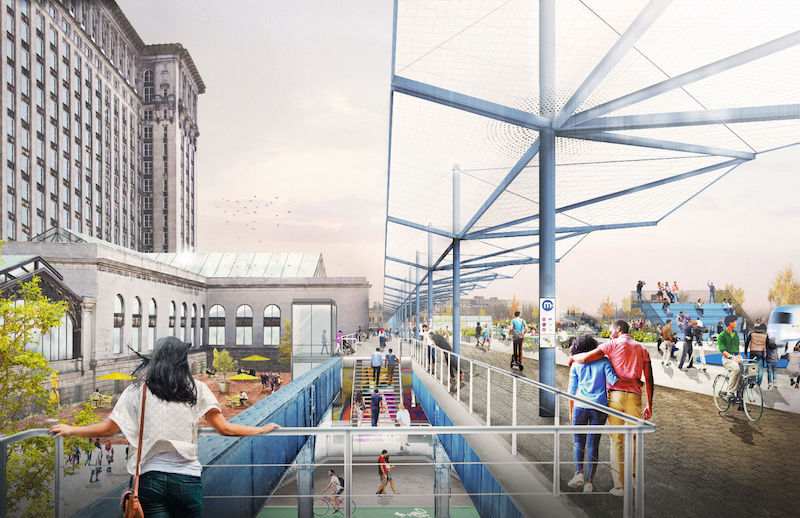
A signature feature of the district will be the revitalization of elevated railroad tracks as a “mobility platform” that's pedestrian-friendly and multipurpose. Image: Practice for Architecture and Urbanism
PAU’s Faulkner—whose firm was involved in the development of New York’s City’s popular High Line—says the Ford district’s mobility platform could have multiple functions that include an event space. He also notes that PAU’s main role on this project “is to make sure the spaces around the building are aligned with what’s going on inside.” To that end, PAU is working with the landscape architecture firm Mikyoung Kim Design.
The district is located next to the underutilized Roosevelt Park that has a street running through it. Faulkner says the site plan calls for that street to be re-routed around the park so as not to disturb the park’s walkability and safety.
Other buildings in the district include The Factory, home to Ford’s autonomous vehicle business unit; and Building West, new construction west of the train station that’s still in the design stage. Pluszczynski says that Ford hasn’t determined yet what Building West will be used for; it could become a training center, she speculates.
The district’s parking needs will be met by hubs located on the site’s periphery. Bagley Parking Hub, with 1,250 slots, has already gone through its design phase (Rossetti is the designer). That hub will enhance street life through exterior artwork, two new public plazas, green spaces, and a tree canopy.
All told, Ford expects 2,500 of its employees will be working within its mobility innovation district by 2022. The district has space to accommodate another 2,500 employees of partners and other businesses.
Other Building Team members on the mobility innovation district project include Jacobs (sustainability), Buro Happold (transportation design), Giffels Webster (CE), Mark Allan & Associates (cost estimating), and Streetsense (market analysis).
Related Stories
Urban Planning | Apr 12, 2024
Popular Denver e-bike voucher program aids carbon reduction goals
Denver’s e-bike voucher program that helps citizens pay for e-bikes, a component of the city’s carbon reduction plan, has proven extremely popular with residents. Earlier this year, Denver’s effort to get residents to swap some motor vehicle trips for bike trips ran out of vouchers in less than 10 minutes after the program opened to online applications.
Urban Planning | Apr 12, 2024
New York City’s safest year for pedestrians due to concerted effort of street redesign, speed restrictions
In 2023, New York City recorded its safest year for pedestrians since record-keeping began in 1910. In a city of 8.5 million people, 101 deaths were due to vehicles striking pedestrians, less than one-third the number of the early 1990s. New York City ramped up its efforts to make walking and biking safer in 2014 when the city reduced its speed limit to 25 miles per hour.
Codes and Standards | Apr 8, 2024
Boston’s plans to hold back rising seawater stall amid real estate slowdown
Boston has placed significant aspects of its plan to protect the city from rising sea levels on the actions of private developers. Amid a post-Covid commercial development slump, though, efforts to build protective infrastructure have stalled.
Mixed-Use | Apr 4, 2024
Sustainable mixed-use districts: Crafting urban communities
As a part of the revitalization of a Seattle neighborhood, Graphite Design Group designed a sustainable mixed-use community that exemplifies resource conversation, transportation synergies, and long-term flexibility.
Codes and Standards | Mar 18, 2024
New urban stormwater policies treat rainwater as a resource
U.S. cities are revamping how they handle stormwater to reduce flooding and capture rainfall and recharge aquifers. New policies reflect a change in mindset from treating stormwater as a nuisance to be quickly diverted away to capturing it as a resource.
Urban Planning | Mar 17, 2024
A new report surveys city dwellers about urban living
Architects are rethinking the city of the future in terms of relieving resident challenges.
MFPRO+ Special Reports | Feb 22, 2024
Crystal Lagoons: A deep dive into real estate's most extreme guest amenity
These year-round, manmade, crystal clear blue lagoons offer a groundbreaking technology with immense potential to redefine the concept of water amenities. However, navigating regulatory challenges and ensuring long-term sustainability are crucial to success with Crystal Lagoons.
Urban Planning | Feb 5, 2024
Lessons learned from 70 years of building cities
As Sasaki looks back on 70 years of practice, we’re also looking to the future of cities. While we can’t predict what will be, we do know the needs of cities are as diverse as their scale, climate, economy, governance, and culture.
Healthcare Facilities | Jan 7, 2024
Two new projects could be economic catalysts for a central New Jersey city
A Cancer Center and Innovation district are under construction and expected to start opening in 2025 in New Brunswick.
Sustainability | Jan 2, 2024
Los Angeles has plan to improve stormwater capture and source 80% of water locally
Los Angeles County’s Board of Supervisors voted for a plan to improve stormwater capture with a goal of capturing it for local reuse. The plan aims to increase the local water supply by 580,000 acre-feet per year by 2045.


